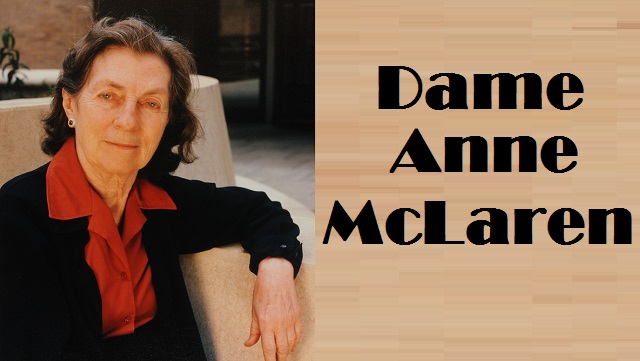Lifestyle
Fun Facts about British biological scientist Dame Anne McLaren

Search engine giant Google celebrates British biological scientist and geneticist Dame Anne McLaren (アン・マクラーレン), who was a leading figure in developmental biology and pioneer of embryology and in vitro fertilization (IVF) techniques, with Doodle on April 26, 2021.
Here is a look at the life and work of Anne McLaren.
Personal
- Birth name: Anne Laura Dorinthea McLaren
- Birthdate: 26 April 1927
- Birthplace: London, England
- Died on: 7 July 2007 (aged 80)
- Death place: England, UK
- Father name: Sir Henry McLaren, 2nd Baron Aberconway
- Mother name: Christabel Mary Melville MacNaghten
- Spouse: Dr. Donald Michie
- Children:
- Susan Fiona Dorinthea Michie (born 19 June 1955)
- Jonathan Mark Michie (born 25 March 1957)
- Caroline Ruth Michie (born 1 August 1959)
- Nationality: British
- Sun sign: Taurus
- Eduction:
- Lady Margaret Hall, Oxford,
- University College London,
- Royal Veterinary College,
- Oxford University
- Known as: Scientist, Biologist, Geneticist, and Zoologist
- Notable work:
- Developmental biology,
- animal genetics
- Notable awards:
- Royal Medal (1990)
- Japan Prize (2002)
40 Interesting Facts about Anne McLaren
- Dame Anne Laura Dorinthea McLaren was a developmental biologist known for her work with embryology in the 20th century.
- Anne McLaren was the first researcher to develop mouse embryos outside of the womb. She experimented by culturing mouse eggs and successfully forming them into embryos, prompting advancements with in vitro fertilization.
- McLaren was born in London, England, on 26 April 1927 to Christabel McNaughten and Henry Duncan McLaren, 2nd Baron Aberconway, who was a politician and industrialist.
- She was born in London and lived there until the war, when her family moved to their estate at Bodnant, North Wales.
- Growing up, Anne McLaren wanted to pursue an education in English literature, yet rather entered Lady Margaret Hall, Oxford, with a scholarship to study zoology.
- During Anne McLaren’s undergraduate work, McLaren became intrigued with genetics, to a limited extent because of her tutor, Edmund Brisco Ford.
- After graduating with an honors degree in zoology in 1949, she proceeded with her research with geneticist John Burdon Sanderson Haldane at University College London on mite infestation in Drosophila.
- Anne McLaren kept on pursuing her education and in 1952 graduated with a Ph.D. from Oxford University where she studied mice neurotropic viruses with professor Kingsley Sanders, advancing her career in genetics.
- On 6 October 1952, Anne McLaren married Donald Michie, who likewise studied and received his Ph.D. at Oxford University.
- They kept working on the genetics of mice with Peter Medawar at University College London and the Royal Veterinary College (RVC) together.
- At RVC, Anne McLaren worked with scientist John Biggers on the development of mouse embryos, prompting a significant technical advance in the history of embryology.
- In 1958, McLaren and Biggers were the first to culture a mouse embryo in the beginning phases for 24 hours, outside of the womb.
- McLaren’s and Biggers’ experiments demonstrated that the environment for growing an embryo is critical to its wellbeing. (They additionally explored different avenues regarding embryos by transferring blastocysts directly from one mother to another, again prompting a successful birth.)
- Their cultural techniques became the basis for in vitro fertilization (IVF). McLaren’s and Biggers’ research has improved fertility treatments and the reproductive health of humans.
- Anne McLaren finished her embryo cultivation research in 1959, that same year that she and her husband divorced.
- After the divorce, McLaren proceeded with her career with research in genetics and fertility of mice at the Institute of Animal Genetics in Edinburgh, UK.
- Over the next fifteen years, Anne McLaren focused on the movement of birth control and embryonic cell research, primarily in the earliest development stages.
- In 1974, McLaren left the institute and moved back to London to serve as the director of the Medical Research Council Mammalian Development Unit.
- This is the place where Anne McLaren emphasized the significance of first understanding the primordial cell, which is the embryonic cells in the early stage of development, before starting research on later stages of the developing embryo.
- In 1975, Anne McLaren was made a Fellow of the Royal Society.
- In 1986, Anne McLaren was made a Fellow of the Royal College of Obstetricians and Gynecologists for her pioneering work on fertility.
- In 1989 she introduced the Ellison-Cliffe Lecture at the Royal Society of Medicine, and from 1990-95 she was the Fullerian Professor of Physiology at the Royal Institution.
- While working, Anne McLaren was additionally associated with the numerous moral discussions about embryo research, leading her to help build the UK’s Human Fertilization and Embryology Act of 1990. This act supports the option of abortion and sets rules for in vitro fertilization and helped reproduction.
- Because of Anne McLaren’s work with the foundation of this act, The Royal Society of London honored McLaren by naming her as its secretary in 1991. The Royal Society perceives researchers who have added to the advantage of the general public through their research.
- From 1991 to 1996, she held the position of Foreign Secretary of the Royal Society, and from 1992 to 1996 the position of Vice President; she was the first female officer in the society’s 330-year history.
- In the wake of authoring 300 papers throughout her career, McLaren retired as the director of MRC Mammalian Development to travel across the globe to teach different researchers in underprivileged societies as secretary of the Royal Society.
- Even though she retired from her past work, McLaren proceeded with her research on stem cells at Gurdon Institute in Cambridge, while acting as a chief research associate in the cancer department.
- For the duration of her life, Anne McLaren partook in scientific progressions with her research with developmental biology. Her experiments with embryos and breakthrough work with in vitro fertilization led her to become the first female officer in the United Kingdom’s Royal Society.
- In 1993, Anne McLaren was made a DBE (Dame of British Empire). From 1993-94, she was president of the British Association for the Advancement of Science, and in 1998 she was made a Fellow of the Academy of Medical Sciences.
- After years of dedication to science, Dame Anne McLaren was likewise elected president of The British Association for Advancement of Science, elevating science to the general public from 1993 to 1994.
- McLaren was a member of the Nuffield Council on Bioethics 1991-2000.
- In 2002, Dame Anne McLaren was awarded the Japan Prize with Andrzej K. Tarkowski for their contributions to mammalian and embryology developmental biology.
- In 2004, Dame Anne McLaren co-founded the Frozen Ark, a repository of genetic material from endangered animals expected for both investigation and potential cloning applications.
- In her later life, Dame Anne McLaren was a member of the Communist Party of Great Britain, which made travel to the USA hard for some time.
- In 2007, she was awarded the March of Dimes Prize in Developmental Biology.
- On 7 July 2007, Dame Anne McLaren (aged 80) died alongside her ex-husband Donald Michie (aged 83) in a car accident while traveling from Cambridge to London.
- The Anne McLaren Papers are housed at the British Library and can be accessed through the British Library catalogue.
- There is a fund in the name of Anne McLaren for support of the scientific study. Cambridge University’s Anne McLaren Laboratory for Regenerative Medicine was opened at the Cambridge Biomedical Campus in 2009.
- Dame Anne McLaren’s experimental results and research are still being used today to help further research in the field of embryology.
- On April 26, 2021, Google celebrated Anne McLaren’s 94th Birthday with a Google Doodle.
-
Health3 weeks ago
Back to Roots: Ayurveda Offers Natural Cure for Common Hair Woes
-

 Tech4 weeks ago
Tech4 weeks agoFrom Soil to Silicon: The Rise of Agriculture AI and Drone Innovations in 2025
-

 Science1 week ago
Science1 week agoJuly Full Moon 2025: Everything You Should Need to Know, When and Where to See Buck Moon
-

 Sports3 weeks ago
Sports3 weeks agoFIBA 3×3 World Cup 2025: Full Schedule, Preview, and How to Watch
-

 Gadget4 weeks ago
Gadget4 weeks agoThings to Know about Samsung Galaxy S26: What’s New and What’s Next
-

 Tech4 weeks ago
Tech4 weeks agoAdobe Firefly App Now Available on iOS and Android Phones to Create AI Images and Videos Anywhere
-

 Sports2 weeks ago
Sports2 weeks agoPrefontaine Classic 2025: Full Schedule, Preview, Field, Events and How to Watch Diamond League Eugene Live
-

 Festivals & Events4 weeks ago
Festivals & Events4 weeks agoEverything You Should Need to Know about Summer Solstice 2025


























